
All images courtesy of Gestalten

Doesn’t the phrase “fleeting architecture” seem like an oxymoron? A successful building is one that’s built to last, right? If you’re in the market for, say, a new house, you probably wouldn’t judge each prospect by how quickly it could be disassembled and transported to another city. At least not right now. But your priorities may be different in 2020.
For the architects and artists whose work is featured in the gorgeous hardcover Spacecraft 2 (Gestalten; $75), designing and promoting ephemeral structures is an M.O.— one that’s expanding and complicating our built environment. The thesis behind the book has been on the minds of designers for decades: permanent buildings don’t always work. They often cost too much money and waste too many materials. And they could easily be razed in 20 years anyway, so what’s the point? In some cases, a pavilion or exhibition space, or even a house, will serve us best if it’s designed with its own dissolution in mind. Plus, a building that’s modular and/or temporary will have a smaller carbon footprint than one built using traditional construction methods.
(more…)
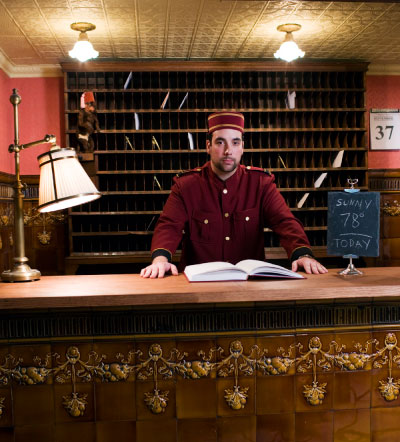
Photography by Gregory Goode

In celebration of youth, oh sweet, flighty and whimsical youth, New York hoteliers Sean MacPherson and Eric Goode of Maritime fame, present their newest venture, the hostel-like Jane Hotel. The landmark building along the Westside Highway was built as a hotel for sailors in 1908. The building’s architect William A. Boring is most famous for designing the Ellis Island immigration station. More fun to note is that in the ‘90s, the hotel ballroom used to hold Hedwig and the Angry Inch shows. Fast-forward and what you have now is a serious renovation and a daring opportunity to make memories. The current Jane hints at fair doses of Darjeeling Limited and The Royal Tenenbaums for inspiration and you get an affordable but incredibly quirky pod hotel featuring nautical cabin rooms for $100 a night with bathrooms down the hall. Room amenities include a compact twin bed with built-in drawers, air conditioning, high-speed Internet access, and flat-screen LCD televisions. Deluxe captains cabins offer queen- and king-sized beds and lovely but limited views of the Hudson. Most coveted is the hotel’s original hand-tiled swimming pool and bathing area. The hotel and lounge have already captured a buzz around town for it’s bohemian allure and relaxed but stylish focus. So whether you’re staying at the hotel, or cruising the city for a drink, stop by for a sit in.
(more…)
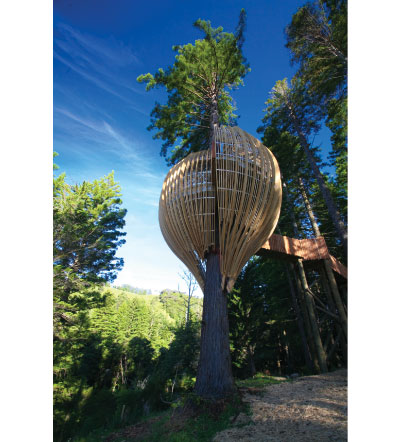
Photography by Lucy Gauntlett

Treehouses are one of our very favorite things. And The Yellow Treehouse Restaurant, just north of Auckland, New Zealand, offers diners a unique treehouse experience. Wrapped around a Redwood, this small eatery serves up to eighteen guests with a full dinner menu, but its setting is the main attraction. With a cocoon-like form, its simple oval shape melds organically with the tree’s trunk, lighting up at night like a lantern hanging in the forest. New Zealand architects Peter Eising and Lucy Gauntlett created this woodsy retreat — a simple structure wrapped around the trunk and structurally tied at top and bottom — so the vertical fins would mimic the trees surrounding it and allow the structure to blend in as if it were a natural growth. Work began on the structure in September, and by early January guests were enjoying their meals with a bird’s-eye view.
pacificenvironments
(more…)

Photography by Jeremy Pelley

Once again, Ace Hotel proves that elegance and simplicity go hand in hand. Similar to their Seattle and Portland locations, Ace Hotel New York offers a wide range of options for the enlightened traveler — everything from bare bones rooms with rates to match up to rockstar suites for those who wish to indulge. All of this comes in a package that’s one part modern and one part traditional, a crossbreed particularly apt for New York City, where opposites collide on a daily basis. Ace Hotel celebrates this wonderful collision and draws on the grit and glamour of New York’s history to make guests feel right at home.
Of course, the masterminds behind Ace don’t just barge into a neighborhood and open up a hotel, rather they note the building’s history — in this case, the former Breslin Hotel, built in 1904 — and observe the local culture as their plan takes shape. This means they’ve maintained the integrity of the original building whenever possible. This comprehensive approach applies to not just the décor and types of rooms; it also influences the way Ace collaborates with local designers, artists, and independent businesses.
(more…)
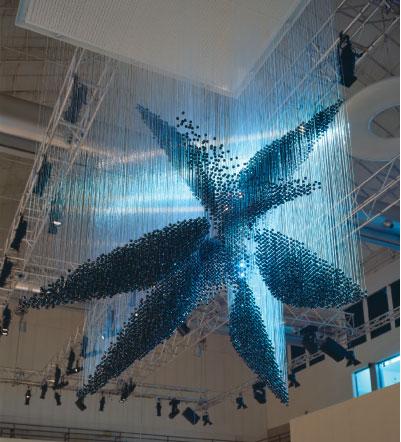
Photography Courtesy of Established & Sons

The Swarm Chandelier is just another example of Zaha Hadid’s genius. Once again the Iraqi-born, London-based architect pushes the boundaries with a piece that defies convention. This time she’s created a chandelier that isn’t technically a chandelier — it has no internal light source — but more of a hanging sculpture. Her Swarm Chandelier, limited to an edititon of eight, resembles a flock of birds or a swarm of insects moving together yet separately. It seems to capture their busy motion in a snapshot, suspended in midair. This still sense of transience is achieved with 16,000 suspended black crystals, each strung by hand on individual wires. The subtle interplay of light reflected on the crystals makes this chandelier come alive, like a hive bustling with activity. Always inventive, Hadid’s designs race on ahead of the pack, surprising us with their extraordinary beauty.
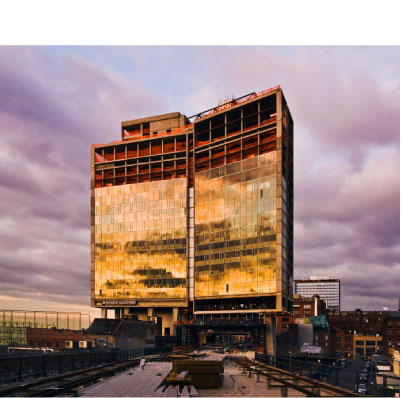
Photography by The Standard New York

After roughly two years of construction in one of the more desolate stretches of Manhattan’s Meatpacking District, the highly anticipated Standard New York is finally pulling back its doors this December — well, sort of. For its soft opening, this latest and most ambitious addition to hotelier André Balazs’ über-sleek suite of Standard hotels will book a limited number of rooms for guests eager to check out what all the fuss is about. In fact, the hotel won’t really have a hard opening so much as a gradual unveiling of different sections as they’re finished — including a restaurant adjacent to the lobby and a bar/lounge on the top floor. The completion date for everything is set for sometime next spring.
However it opens, the Standard will inject a much-needed dose of style and bustle into the neighborhood, which has become littered with sub-standard destinations of late. The eighteen-floor, 335-room hotel is a bold addition to the Westside skyline, consisting of two semi-separate pieces set at an angle and supported by a series of strategically placed columns. Half of the hotel literally straddles the soon-to-be-revitalized High Line, making it perhaps the most dramatic High Line-related architecture we’ve seen yet. And although it doesn’t yet connect to the High Line (special permits are required), reps for the hotel don’t discount the possibility.
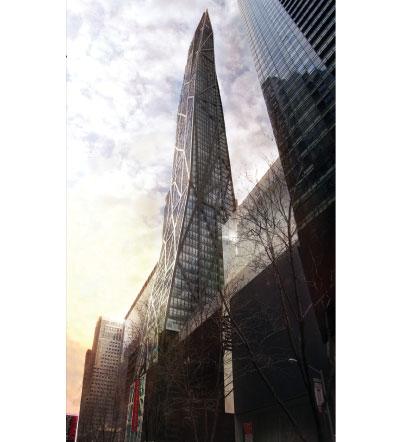

New York’s MoMA may have recently opened a new building, but its continued ambition couldn’t be any more obvious. Late last year, MoMA announced it had struck a deal with real-estate development firm Hines to turn the museum’s adjacent vacant lot into a monumental seventy-five-story tower of concrete and glass. For its part, the museum will pick up 40,000 square feet of exhibition space in the Jean Nouvel-designed building. Across the Atlantic, Nouvel has been reshaping the post-modern look of Europe with buildings like the new Philharmonic in Paris and his older Institut du Monde Arabe, setting the tone for metropolises worldwide. Now, in his third and largest building in the US, Nouvel’s genius is making a splash stateside. Above the museum floors, the building will house 120 private luxury residences and a 100-room “seven-star” hotel — whatever that is. With this project underway, New York City will once again set the high-rise standard in architecture, not simply for building big but rather for creating structures that are both smart and culturally relevant. While many architects may have a vision for the future, few are as futuristically epic as Jean Nouvel’s.
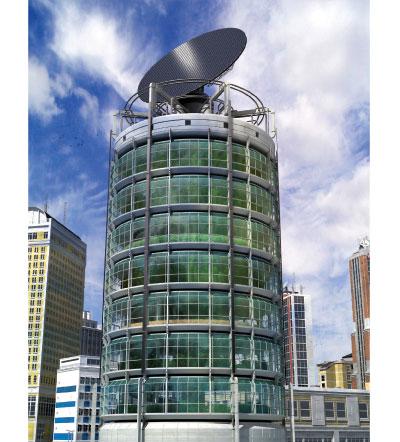
Design by Chris Jacobs & Rolf Mohr

We know that stacking people in city apartments leaves a smaller ecological footprint than sprawling McMansions across suburbia. Imagine applying the same idea to growing food. Could metropolises transform from parasitic centers of consumption into hot spots of sustainable production? A team of Columbia University environmentalists is designing a “vertical farm” by combining greenhouse technology with high-rise food cultivation. The goal? To create a self-sustaining building capable of producing a year-round balanced diet for 50,000-plus urban dwellers. All crops — including fish and livestock — would be grown organically and ethically, solar panels would power 24-four-hour grow lights, and irrigation water would come from filtered sewage purified via a series of ponds filled with sludge-loving organisms.
(more…)





 Facebook
Facebook Permalink
Permalink Digg
Digg Reddit
Reddit LinkedIn
LinkedIn StumbleUpon
StumbleUpon Tumblr
Tumblr








